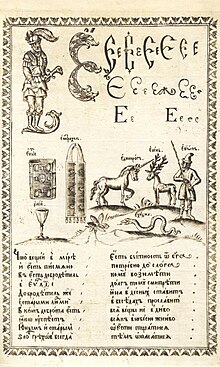| This article needs additional citations for verification. Please help improve this article by adding citations to reliable sources. Unsourced material may be challenged and removed. Find sources: "Ye" Cyrillic – news · newspapers · books · scholar · JSTOR (February 2007) (Learn how and when to remove this message) |

E (Е е; italics: Е е), known in Russian and Belarusian as Ye, Je, or Ie, is a letter of the Cyrillic script. In some languages this letter is called E. It commonly represents the vowel or , like the pronunciation of ⟨e⟩ in "yes". It was derived from the Greek letter epsilon (Ε ε), and the shape is very similar to the Latin letter E or another version of E (Cyrillic).
Ye is romanized using the Latin letter E for Bulgarian, Serbian, Macedonian, Ukrainian and Rusyn, and occasionally Russian (Озеро Байкал, Ozero Baykal), Je for Belarusian (Заслаўе, Zaslaŭje), Ye for Russian (Европа, Yevropa), and Ie occasionally for Russian (Днепр, Dniepr) and Belarusian (Маладзе́чна, Maladziečna).
Usage
Russian and Belarusian
- At the beginning of a word or after a vowel, Ye represents the phonemic combination /je/ (phonetically or ), like the pronunciation of ⟨ye⟩ in "yes". Ukrainian uses the letter ⟨є⟩ (see Ukrainian Ye) in this way.
- Following a consonant, Ye indicates that the consonant is palatalized, and represents the vowel /e/ (phonetically or ), like the pronunciation of ⟨e⟩ in "yes".
In Russian, the letter ⟨е⟩ can follow unpalatalized consonants, especially ⟨ж⟩, ⟨ш⟩, and ⟨ц⟩. In some loanwords, other consonants before ⟨е⟩ (especially ⟨т⟩, ⟨д⟩, ⟨н⟩, ⟨с⟩, ⟨з⟩, and ⟨р⟩) are also not palatalized, see E (Cyrillic). The letter ⟨е⟩ also represents /jo/ (as in "yogurt") and /o/ after palatalized consonants, ⟨ж⟩, and ⟨ш⟩. In these cases, ⟨ё⟩ may be used, see Yo (Cyrillic). In unstressed syllables, ⟨e⟩ represents reduced vowels like , see Russian phonology and Vowel reduction in Russian.
Bulgarian, Serbian, Macedonian, Ukrainian and Rusyn
This letter is called E, and represents the vowel phoneme /e/ (phonetically or ), like the pronunciation of ⟨e⟩ in the word "set".
Mongolian
The letter represents the sound /jo/ at the beginning of words (yo represents /jɔ/), and also represents /je/ at the beginning of some words and in the middle or end of words and /e/ in Russian loanwords and transcriptions of foreign names.
Turkic languages and Tajik
In Turkic languages utilizing the Cyrillic script (such as Kazakh, Kyrgyz and Uzbek) and in Tajik, Ye is used to represent the phoneme e~ɛ, both word-finally and medially. Isolated, word-initially, or vowel-succeeding, this letter is substituted with the letter Э. If the letter Ye occurs word-initially, isolated, or vowel-succeeding, it represents the phoneme /je/~/jɛ/. This is done in imitation of the Russian usage, as many of these languages received Cyrillic orthographies as part of Russification in the Soviet Union.
Computing codes
| Preview | Е | е | ||
|---|---|---|---|---|
| Unicode name | CYRILLIC CAPITAL LETTER IE | CYRILLIC SMALL LETTER IE | ||
| Encodings | decimal | hex | dec | hex |
| Unicode | 1045 | U+0415 | 1077 | U+0435 |
| UTF-8 | 208 149 | D0 95 | 208 181 | D0 B5 |
| Numeric character reference | Е |
Е |
е |
е |
| Named character reference | Е | е | ||
| KOI8-R and KOI8-U | 229 | E5 | 197 | C5 |
| Code page 855 | 169 | A9 | 168 | A8 |
| Windows-1251 | 197 | C5 | 229 | E5 |
| ISO-8859-5 | 181 | B5 | 213 | D5 |
| Macintosh Cyrillic | 133 | 85 | 229 | E5 |
See also
- the Latin letter E
- the Latin letter É
- the Greek letter Ε
- Ukrainian Ye
